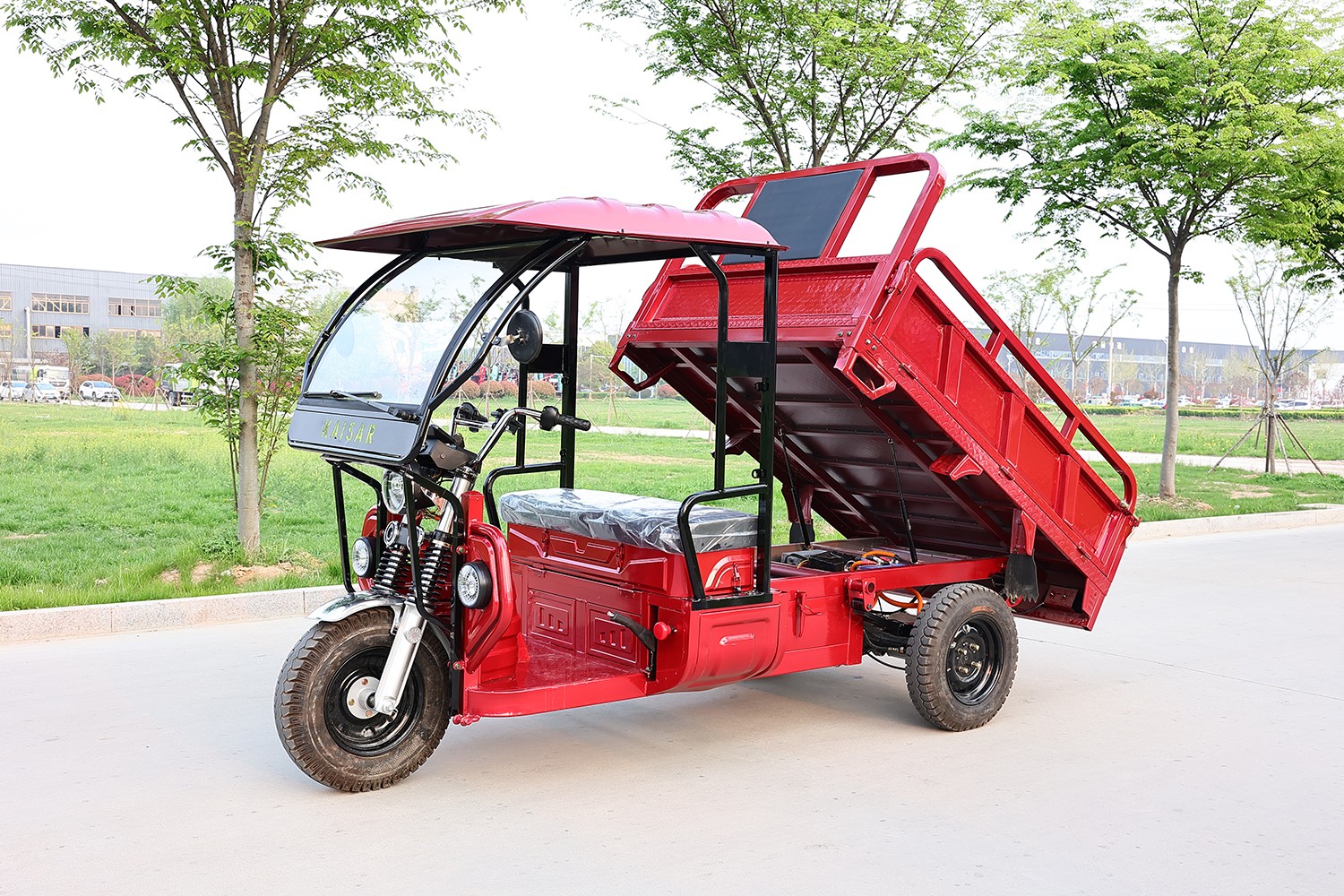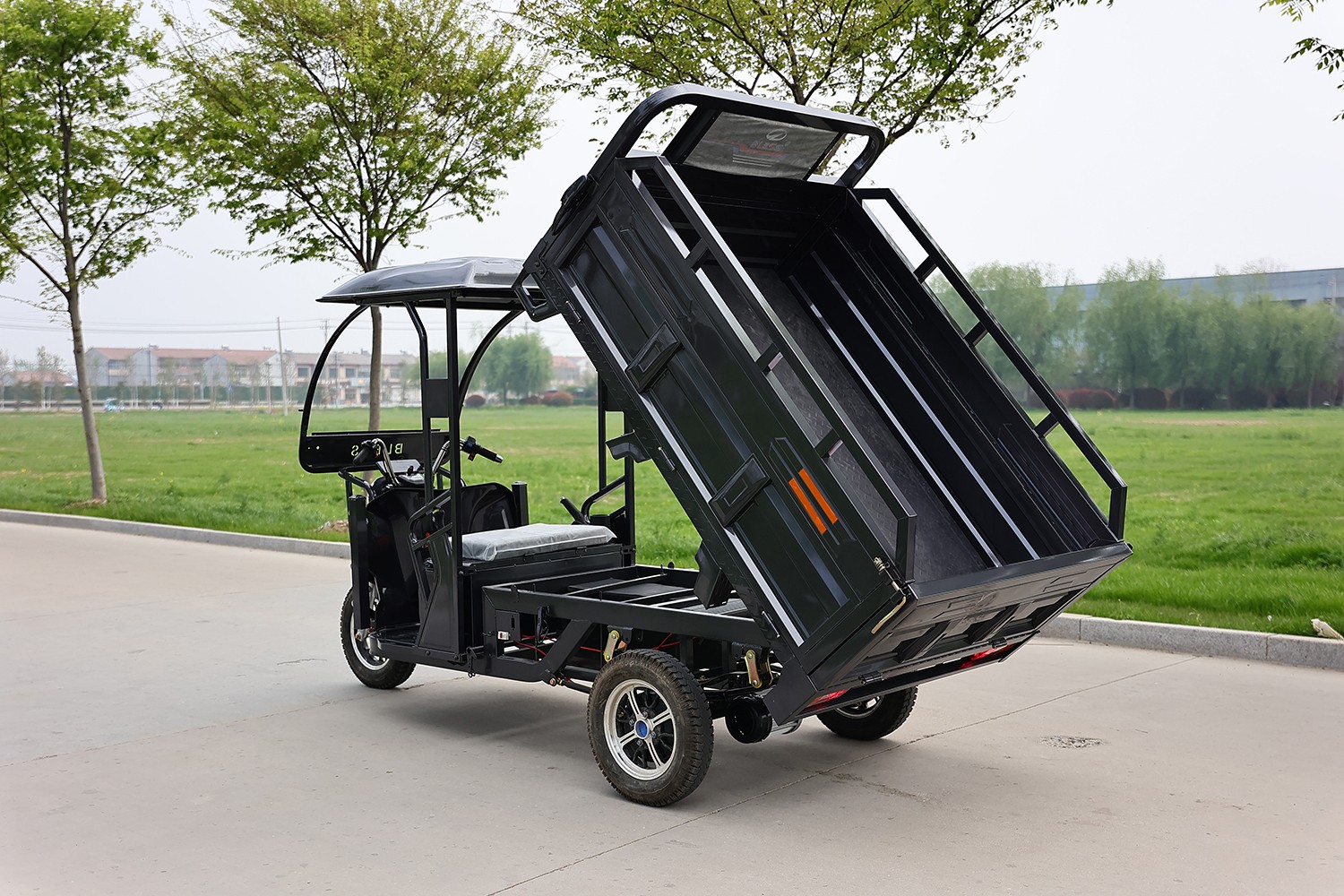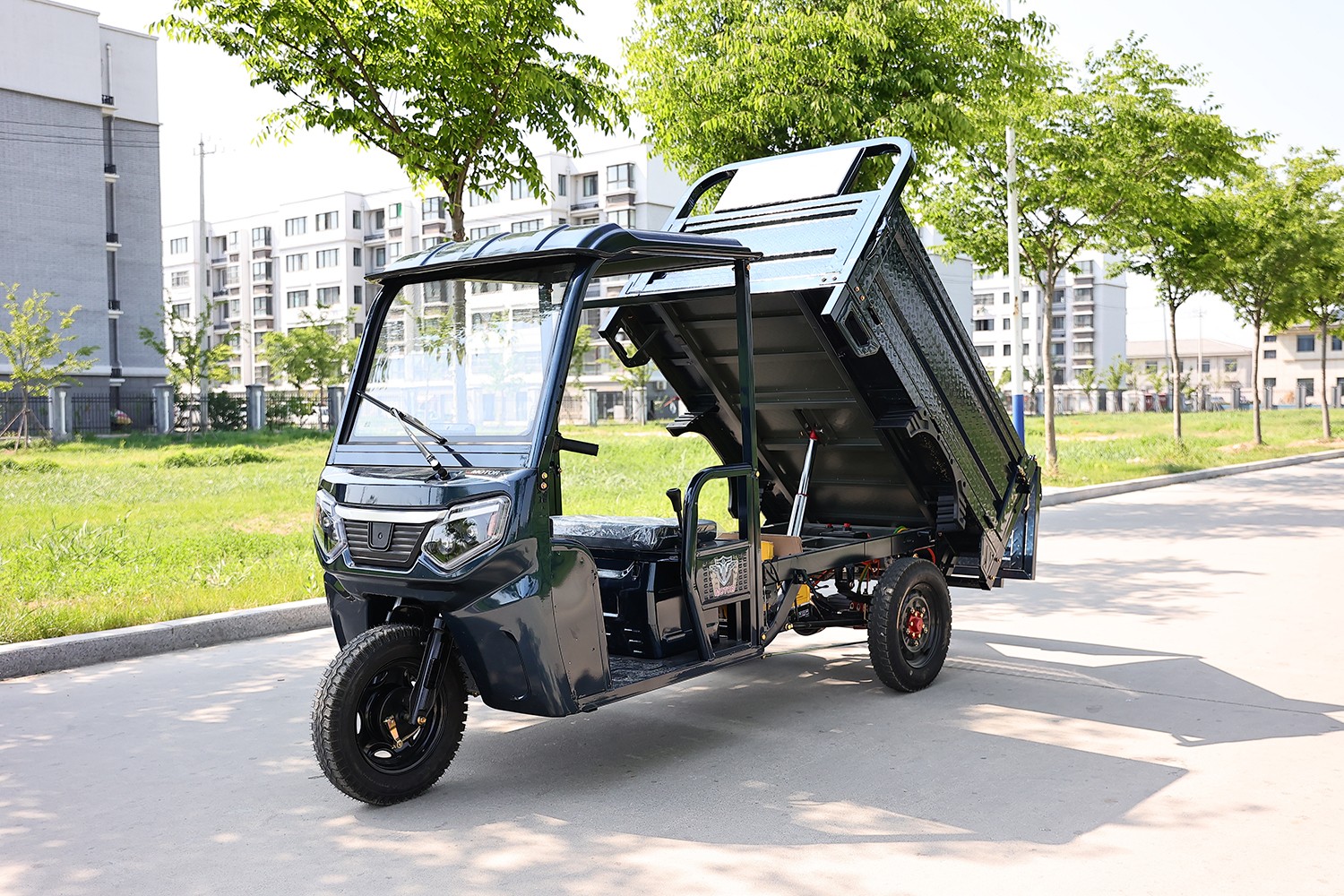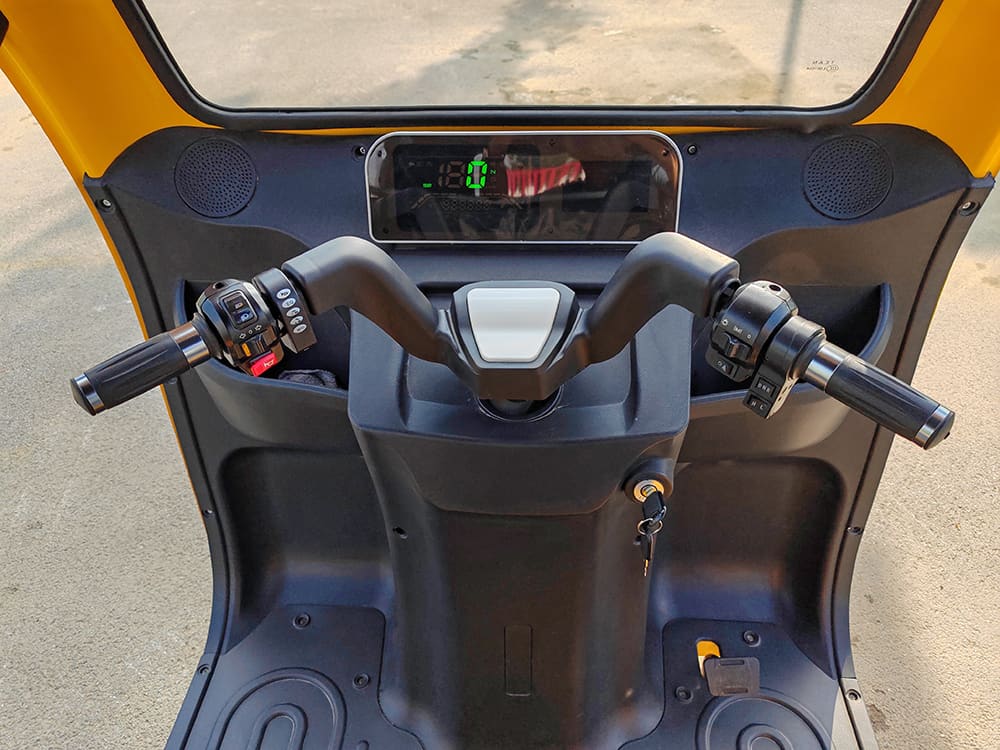This article provides a comprehensive overview of lithium battery electric cargo tricycles, exploring their benefits, applications, and key considerations for businesses seeking efficient and sustainable transportation solutions. Whether you’re a fleet manager, a small business owner, or a logistics provider, this guide will equip you with the knowledge you need to make informed decisions about incorporating electric tricycles into your operations, explaining why this article is a must-read for anyone interested in this revolutionary mode of transportation.
1. What is a Lithium Battery Electric Cargo Tricycle?
A lithium battery electric cargo tricycle, also known as an electric trike or 3 wheel electric cargo vehicle, is a three-wheeled vehicle powered by a rechargeable lithium battery. It’s designed for transporting goods or passengers, offering a sustainable and cost-effective alternative to traditional gasoline-powered vehicles. These tricycles combine the maneuverability of a bicycle with the carrying capacity of a small truck, making them ideal for navigating congested city streets and making last-mile deliveries. These are designed for cargo delivery.
Electric tricycles typically consist of a sturdy frame, a powerful electric motor (often 800W or more), a lithium battery pack (48V or 60V being common), a controller, and a braking system (often including front disc brakes and rear disc brakes or rear drum brakes). Some models also feature an enclosed cabin for the driver or passengers.
2. Why Choose a Lithium Battery Over Lead-Acid for Your Electric Tricycle?
The choice between a lithium battery and a lead-acid battery is crucial for electric tricycle performance. Lithium batteries offer several significant advantages:
- Higher Energy Density: Lithium batteries store more energy per unit of weight, resulting in a longer range for the electric tricycle on a single charge. This allows the vehicle to travel longer distances.
- Longer Lifespan: Lithium batteries have a significantly longer lifespan, typically lasting 2-4 times longer than lead-acid batteries. This reduces the frequency of battery replacements, lowering long-term costs.
- Faster Charging: Lithium batteries support fast charging capabilities, significantly reducing downtime compared to the lengthy charging times of lead-acid batteries.
- Lighter Weight: Lithium batteries are much lighter than lead-acid batteries, improving the overall efficiency and handling of the electric tricycle.
- Better Performance in Varying Temperatures: Lithium batteries maintain better performance in extreme temperatures, whereas lead-acid battery performance can significantly degrade in cold or hot weather.
While lead-acid batteries may have a lower upfront cost, the long-term benefits of lithium batteries (longer lifespan, better performance, and faster charging) make them the superior choice for most electric tricycle applications.
3. Who Can Benefit from Using Electric Cargo Tricycles?
Electric cargo tricycles offer a versatile solution for a wide range of users:
- Last-Mile Delivery Companies: Electric tricycles are perfect for navigating congested urban areas and making quick, efficient deliveries.
- Logistics Providers: They provide a cost-effective and environmentally friendly way to transport goods within warehouses, distribution centers, and short-haul routes.
- Small Business Owners: Businesses involved in local transport and delivery (e.g., food vendors, florists, small retailers) can benefit from the affordability and maneuverability of electric tricycles.
- Ride-Sharing Companies (in specific regions): In some areas, electric passenger tricycles are used for ride-sharing services, providing a convenient and eco-friendly alternative to taxis.
- Tourism Operators: Electric tricycles can be used for guided tours or passenger transport in tourist destinations.
- Transportation Companies: They offer a sustainable option for short-distance passenger transport, particularly in areas with limited access for larger vehicles.
- Government Agencies: For specific applications such as park maintenance, waste collection, or local deliveries.
- Individual Consumers: Depending on local regulations, individuals may use electric tricycles for personal transportation or cargo hauling.

4. What are the Key Features to Look for in an Electric Cargo Tricycle?
Selecting the right electric cargo tricycle requires careful consideration of several key features:
- Motor Power: Choose a motor with sufficient power (e.g., 800W, 1000W) to handle your typical load and terrain. Higher power is needed for steep hills or heavier loads.
- Battery Capacity and Range: Consider the required range for your operations and select a battery with adequate capacity (measured in Amp-hours or Watt-hours). Lithium battery electric tricycles offer significantly better range than those with lead-acid batteries.
- Load Capacity: Ensure the tricycle’s load capacity meets your needs, whether you’re transporting lightweight packages or heavier goods.
- Braking System: A reliable brake system is essential for safety. Look for models with front disc brakes and rear disc or drum brakes, and consider hydraulic brakes for enhanced stopping power.
- Durability and Build Quality: Opt for a tricycle with a robust frame and high-quality components to ensure long-term reliability and withstand daily use. Look for features that prevent rust.
- Suspension: A good suspension system provides a smoother ride, especially on uneven roads.
- Tires: Choose tires appropriate for your operating environment (e.g., puncture-resistant tires for city streets).
- Comfort Features: Consider features like a comfortable seat, ergonomic handlebars, and a user-friendly display.
5. How Do Electric Tricycles Comply with Safety Standards and Regulations?
Safety is paramount. Reputable electric tricycle manufacturers ensure their products comply with relevant safety standards and regulations. These may include:
- EEC Certification (for Europe): The EEC (European Economic Community) certificate indicates compliance with European safety and environmental standards.
- DOT Compliance (for the USA): The Department of Transportation (DOT) sets safety standards for motor vehicles in the United States.
- Local Regulations: Compliance with specific local regulations regarding electric vehicle operation, licensing, and safety requirements is crucial. Reputable manufacturers will be aware of these requirements in their target export markets.
- Braking System Standards: Compliance with standards for braking performance and reliability.
- Lighting and Visibility: Adequate headlights, taillights, and reflectors are essential for safe operation, especially at night.
Always inquire about the specific certifications and compliance standards met by the electric tricycle you are considering.
6. What are the Maintenance Requirements for Electric Cargo Tricycles?
Electric tricycles generally require less maintenance than gasoline-powered vehicles, but regular upkeep is still essential:
- Battery Care:
- Regularly check the battery’s voltage and charge level.
- Follow the manufacturer’s recommendations for charging and storage.
- Avoid completely discharging the lithium battery.
- Store the tricycle in a cool, dry place when not in use.
- Brake Inspection: Regularly inspect brake pads and discs for wear and tear. Replace them as needed.
- Tire Pressure: Maintain proper tire pressure for optimal performance and handling.
- Chain Lubrication (if applicable): If the tricycle has a chain drive, lubricate the chain regularly.
- Motor Inspection: Periodically check the motor for any unusual noises or vibrations.
- Electrical System Check: Regularly inspect wiring and connections for any damage or corrosion.
- Frame Inspection: Check the frame for any cracks or damage.

7. How to Choose the Right Electric Tricycle Supplier?
Choosing a reliable supplier is as important as selecting the right tricycle model. Here are some key factors to consider, keeping in mind my business identity (Allen, from China, a factory specializing in electric tricycles) and my target customer (Mark Thompson, USA, company owner/fleet manager):
- Experience and Reputation: Look for a supplier with a proven track record in manufacturing and exporting electric tricycles. Check online reviews and testimonials. A company like ZHIYUN, with multiple production lines, demonstrates a commitment to manufacturing capacity and quality.
- Product Quality: Prioritize suppliers who use high-quality components (motors, lithium batteries, frames) and adhere to strict quality control processes. Ask about their quality certifications.
- Customization Options: If you have specific requirements (e.g., custom branding, specific load capacity, or features), choose a supplier who offers customization options. Many factories in China, including ZHIYUN, are flexible with customization for B2B clients.
- Compliance with Standards: Ensure the supplier’s products comply with the relevant safety and regulatory standards in your target market (e.g., DOT compliance for the USA, EEC for Europe).
- After-Sales Service and Spare Parts Availability: Choose a supplier who provides reliable after-sales service, including technical support and readily available spare parts. This addresses Mark Thompson’s key concern about long-term maintenance support.
- Communication and Responsiveness: Select a supplier who communicates clearly and responds promptly to your inquiries. This is crucial for a smooth and efficient business relationship. As Allen, I would emphasize my direct communication and understanding of Mark’s needs.
- Logistics, Shipping, and Payment: Clear terms of business, including shipping, costs, and payment methods.
- Visit the Factory (if possible): If feasible, visiting the factory (e.g., ZHIYUN’s facilities in China) allows you to assess their production processes, quality control, and overall capabilities firsthand. This is especially relevant for Mark, who sources from developing countries. Attending exhibitions where the supplier is present (a key promotion channel for ZHIYUN) is another excellent way to connect.
8. What is the Future of Electric Tricycles in Urban Logistics?
The future of electric tricycles in urban logistics is exceptionally bright. Several factors contribute to this positive outlook:
- Growing Demand for Sustainable Solutions: Increasing environmental concerns and regulations are driving the adoption of electric vehicles, including tricycles, for urban transportation.
- E-commerce Growth: The continued expansion of e-commerce fuels the need for efficient and cost-effective last-mile delivery solutions, where electric tricycles excel.
- Urbanization: As cities become more densely populated, the maneuverability and compact size of electric tricycles make them ideal for navigating congested streets.
- Technological Advancements: Ongoing advancements in battery technology, motor efficiency, and vehicle design are further enhancing the performance and capabilities of electric tricycles. Expect to see longer ranges, faster charging times, and increased load capacities in the future.
- Government Incentives: Many governments are offering incentives (e.g., subsidies, tax breaks) to promote the adoption of electric vehicles, further accelerating the growth of the electric tricycle market.
- Focus on Cost Reduction: Businesses are constantly seeking ways to reduce operating costs. Electric tricycles offer significant savings on fuel and maintenance compared to gasoline-powered vehicles.
9. How Does the Cost of an Electric Cargo Tricycle Compare to a Gasoline Tricycle?
While the initial purchase price of an electric cargo tricycle (especially one with a lithium battery) may be higher than a comparable gasoline tricycle, the total cost of ownership is often lower over the vehicle’s lifespan. This is due to several factors:
- Lower Fuel Costs: Electricity is typically much cheaper than gasoline, resulting in significant savings on fuel expenses.
- Reduced Maintenance: Electric tricycles have fewer moving parts than gasoline-powered vehicles, reducing maintenance requirements and costs.
- Longer Lifespan (of lithium batteries): Lithium batteries have a much longer lifespan than lead-acid batteries and gasoline engines, reducing the frequency of replacements.
- Government Incentives: Subsidies and tax breaks can help offset the initial purchase price of an electric tricycle.
- No exhaust emissions: Contributing to cleaner city and reducing health risks.
A detailed cost analysis, considering factors like fuel prices, electricity rates, maintenance costs, and expected vehicle lifespan, is recommended to accurately compare the total cost of ownership for your specific situation.

10. Where Can I Find High-Quality Electric Tricycles for My Business?
Finding a reputable supplier is key to acquiring high-quality electric tricycles. Here are some avenues to explore:
- Online Marketplaces (B2B): Websites like Alibaba, Made-in-China, and Global Sources connect buyers with manufacturers, primarily in China. These platforms allow you to browse a wide range of products and compare suppliers.
- Industry Exhibitions: Attending trade shows and exhibitions focused on electric vehicles or logistics provides an excellent opportunity to meet manufacturers, see products in person, and discuss your needs directly. This aligns with ZHIYUN’s promotion strategy.
- Direct Contact with Manufacturers: Reach out to manufacturers directly through their websites or contact information found online. This allows for personalized communication and the ability to ask specific questions. ZHIYUN’s website (https://www.autotrikes.com/) is a good starting point.
- Google Search: Using specific search terms like "lithium battery electric cargo tricycle manufacturer China," "electric passenger tricycle supplier USA," or "electric logistics tricycle exporter" can help you find relevant suppliers.
- Referrals: Seek recommendations from other businesses or industry contacts who have experience with electric tricycles.
Remember to apply the supplier selection criteria outlined in Section 7 when evaluating potential manufacturers. Specifically, consider manufacturers in China, like ZHIYUN, known for their expertise in electric tricycle production and their ability to cater to international markets. For instance, you might look at models like the Electric cargo tricycle HJ20 for cargo needs or the EV31 Electric passenger tricycle for passenger transport. Consider the Van-type logistics electric tricycle HPX10 if a fully enclosed cargo area is essential for your operations, this offers protection for goods.

Key Takeaways:
- Lithium battery electric cargo tricycles offer a sustainable, cost-effective, and efficient solution for urban transportation and logistics.
- Lithium batteries provide significant advantages over lead-acid batteries in terms of range, lifespan, charging time, and weight.
- Electric cargo tricycles are suitable for a wide range of applications, including last-mile delivery, logistics, small business operations, and passenger transport.
- Carefully consider motor power, battery capacity, load capacity, braking system, durability, and compliance with safety standards when choosing an electric tricycle.
- Select a reputable supplier with experience, high-quality products, customization options, after-sales service, and clear communication.
- The future of electric tricycles in urban logistics is bright, driven by sustainability concerns, e-commerce growth, urbanization, and technological advancements.
- The total cost of ownership for an electric tricycle is often lower than a gasoline tricycle due to lower fuel and maintenance costs.
- Explore online marketplaces, industry exhibitions, and direct contact with manufacturers to find high-quality electric tricycles. Prioritize suppliers in regions known for electric vehicle manufacturing, such as China.
Post time: 03-21-2025




